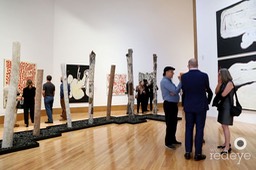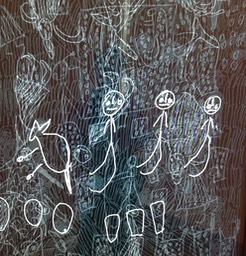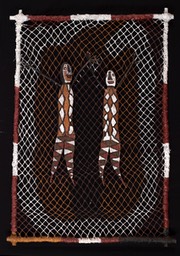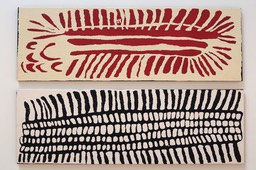Henry Skelton, Kluge-Ruhe Collection curator, describes the contemporary relevance of the exhibition "Marking the Infinite: Contemporary Women Artists from Aboriginal Australia" at the Patricia and Phillip Frost Art Museum - FIU. This exhibition featuring work by nine extraordinary artists, is from the Miami collection of Debra and Dennis Scholl.
Collector, Dennis Scholl's commissioning of work from seven Aboriginal Australian artists allowed them to increase the scale of their practice to a level customary in contemporary museum exhibitions. Their work is included in "Marking the Infinite: Contemporary Women Artists from Aboriginal Australia" at the Patricia and Phillip Frost Art Museum - FIU.
Dennis Scholl describes the traditional and contemporary function of Memorial Poles in Aboriginal Australian culture. Nine poles from the Debra and Dennis Scholl collection are included in the exhibition "Marking the Infinite" at the Patricia and Phillip Frost Art Museum - FIU
When contemporary art meets aboriginal traditions, a remarkable show follows
If visitors to the “Marking the Infinite” exhibition at the Patricia and Phillip Frost Art Museum at FIU sense the artists’ geographic origins, it’s not because the show’s organizers sought to highlight them. While the sumptuous catalog intersperses photos of the artists and the stunning landscapes of their home territories among essays and images of their work, Frost curator Klaudio Rodriguez limited explanatory texts to allow the artists and their work to speak for themselves.
Speak they do, in bold abstract shapes and intricate, minute patterns that address both contemporary life and traditions deeply tied to the rugged land of Australia.
Like “No Boundaries,” a 2015 show at the Pérez Art Museum Miami featuring works by nine male tribal elders, the artworks here are drawn from the collection of Dennis and Debra Scholl, who have focused in recent years on contemporary aboriginal art. The Frost exhibition showcases some 70 drawings, paintings and sculptures by nine indigenous Australian women artists, most of them still living.
A procession of nine peeled and painted tree trunks rise erect, but slightly wobbly, from a bed of black rocks. These six-foot plus memorial poles are nearly dwarfed by a pair of shape-shifting, white-on-black paintings that climb and dominate the exhibit entry. Rather than going by a strict plan, Rodriguez hung the exhibition intuitively, he said, particularly exploiting the gallery’s vertical spaces to create an immersive experience. The paintings were created flat on the ground, without top or bottom, which gave the curator latitude to show them as he felt best.
While the sculptures’ origins will be recognizable to some viewers, many of the paintings fit so neatly with contemporary global abstraction that they may not seem “aboriginal” at all. Loose geometric shapes, rigorous lines and multi-layered patterns could belong to so many genres. Here, the “dot’’ paintings typically associated with aboriginal work are oversized (as in the several works of the late Wintjiya Napaltjarri), or so prolific that they feel like a vast, starry sky seen from a light-free wilderness.
“This is a show really about nine contemporary artists who happen to be aboriginal Australian women,” said Dennis Scholl. The powerful works speak to current global themes in the context of communities whose art-making traditions date back 40,000 years.
Most of the artists here are of advanced age and stature, living in communities ranging from the central desert to the subtropical northeast. While the territories from which they come are physically isolated both from modern cities and one another, Scholl describes a shared understanding. “They realize their culture is becoming marginalized, and the only way to preserve their culture, their tradition, their heritage, is to bring their art out into the world and to have it reach global understanding.”
In Australia, aboriginal women have been “officially” painting only since the late 1980s. Before then, only men were allowed to create images referring to the sacred creation narratives of the various clans. Though each narrative stands on its own, the stories are interconnected.
During a gallery tour, Scholl described the artwork by women as more adventurous than that of aboriginal men — less bound to traditional designs and literal depictions, and more likely to convey a sense of being in the country with the vital natural forces that shape their world.
Regina Pilawuk Wilson, for instance, grew up in the Northern Territory settlement of Peppimenarti, where she learned to gather and weave grasses into fishnets and bags. She has turned these domestic forms into brilliant, multi-hued designs, independent of their original functionality. The original sand palm and pandanus fiber weavings are now executed as exquisite, nuanced paintings — some flaring out in a radius, others forming grids — both holding mesmerizing power.
Many of the works here were commissioned directly from the artists, including Wilson’s “Sun Mat” and “Syaw (Fishnet)” paintings that stretch nearly 12-feet long. Her largest pieces are dramatically displayed as they were painted — horizontally. The majestic “Syaw” presents a swath of interlocking shapes that resemble layered patches of fabric, with subtly glowing autumnal tones enlivened by intermittent sections of contrasting white lines.
Other works reflect the change from seeing the world as a center with edges to viewing it as a web of connections. Lena Yarinkura invokes that web with her mermaid-like “Yawkyawk” creatures and “Spiders.” Consulting scholar Henry Skerrit quotes the artist: “When he goes round and round Spider is like a computer — he can make everything. So, it’s still old, from the beginning, but also new ideas.”
Nearly all the works here pay homage to the connections between land, natural forces and humanity. Such is the case with Nonggirrnga Marawili’s bold white diamond-shaped lattices of parallel lines over deeper colors, a combination that evokes the interplay of lightning and water on the rocks of her northeastern coastal home territory. These zigzag motifs honor and animate mutually transforming connections between the spirit, natural and human worlds.
Humans, of course, aren’t always benevolent — a historical reality that dates at least from the 1770 arrival of Captain James Cook. Scholl says that these artists “are concerned about the impact of the world on their culture, and they use their art making as a way to preserve — hopefully — their culture, by inviting other people into it.”
Angelina Pwerle’s Bush Plum paintings, for example, reflect the desert terrain of her ancestral estate in the Alice Springs region, dotted with the white flowers of this traditionalforage food. Bush Plum is also part of an ancestral creation story, and these cloudy, stippled compositions are equally suggestive of vast spaces or the tiny pores of animal skin. This interweaving of the immense with the infinitesimal requires immeasurable hours of work. The result is a meditative veil that invites contemplation.
Gulumbu Yunupingu, who died in 2012, once explained that her “Ganyu,” or star, paintings were inspired by traditional stories about celestial beings and links between the earth, sky and spirits of the dead. So perhaps it should be no surprise that the artist created her colors by mixing water with local mineral oxides, applied with a simple tool crafted from a twig, wrapped with strands of her own hair. Her dense, layered matrices of cross-shaped motifs form a lulling rhythm on sheets of bark and memorial poles.
Many of the artists included here are chief breadwinners and social leaders in their communities that, despite Australia’s global stature, often suffer from poor health care, under-resourced education and limited economic opportunities. Fortunately, the art market is providing cash that is helping to raise the tide.
IF YOU GO
What: “Marking the Infinite: Contemporary Women Artists from Aboriginal Australia”
Where: Patricia and Phillip Frost Art Museum at FIU 10975 SW 17th St.
When: Through May 7
Info: thefrost.fiu.edu
Read more here: http://www.miamiherald.com/entertainment/visual-arts/article139247483.html#storylink=cpy



